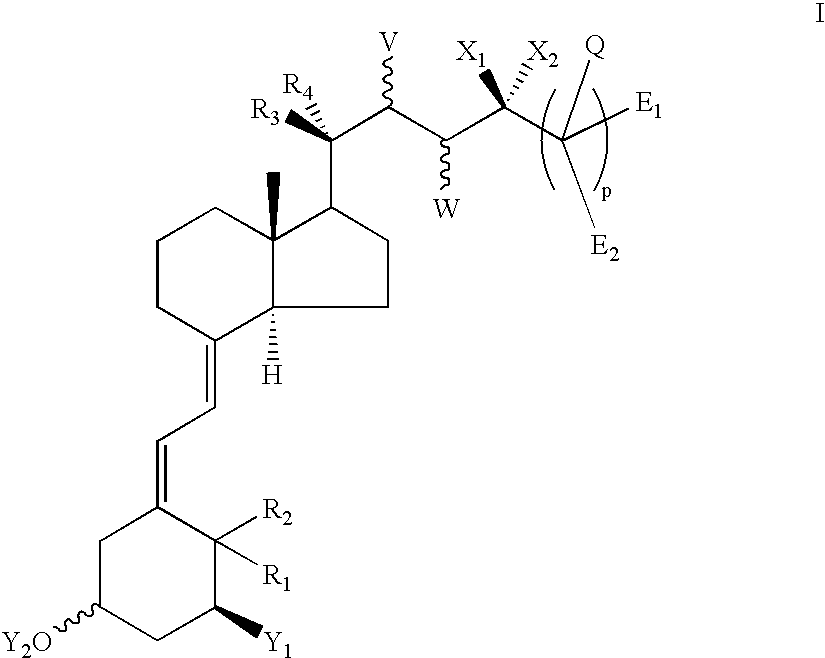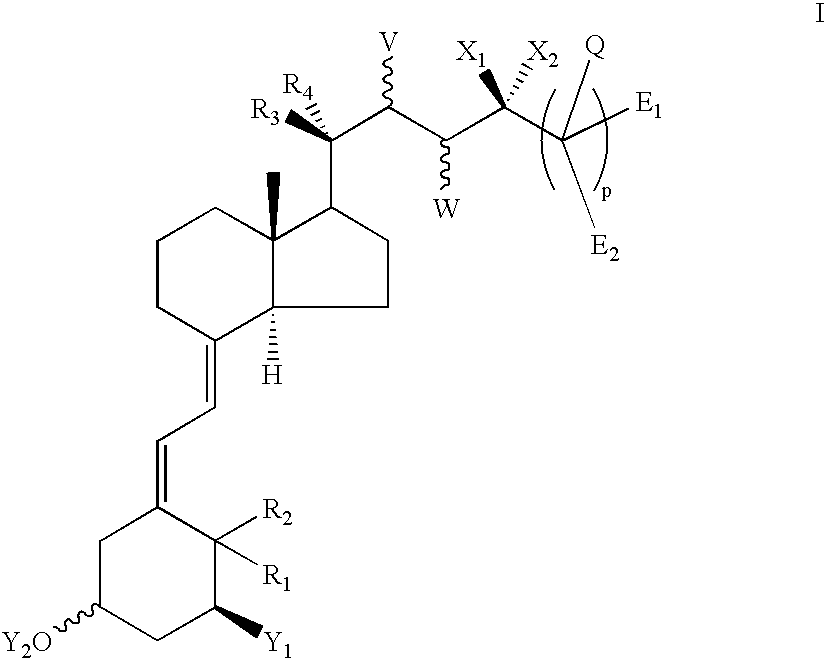Vitamin D derivatives with phosphorus atoms in the side chains
a technology of phosphorus atoms and derivatives, which is applied in the direction of phosphorous compound active ingredients, drug compositions, metabolic disorders, etc., can solve the problems of metabolic destabilization of derivatives, hypocalcemia, and toxic effect on calcium metabolism
- Summary
- Abstract
- Description
- Claims
- Application Information
AI Technical Summary
Problems solved by technology
Method used
Image
Examples
example 2
(5Z,7E,22E)-(1S,3R,24S)-(1,3,24-Trihydroxy-24a-homo-9,10-secochola-5,7,10(19),22-tetraen-24a-yl)phosphonic acid dimethyl ester 7a and (5Z,7E,22E)-(1S,3R,24R)-(1,3,24-trihydroxy-24a-homo-9,10-secochola-5,7,10(19),22-tetraen-24a-yl)phosphonic acid dimethyl ester 7b
a) 80 mg of ketone 4 is dissolved in 2 ml of dichloromethane, and 8 ml of ethanol is added under nitrogen. 52 mg of cerium trichloride (heptahydrate) and 6 mg of sodium borohydride are added in succession at 0.degree. C. and stirred for 15 more minutes. Then, sodium chloride solution is added, extracted with ethyl acetate, the organic phase is washed with sodium chloride solution and dried on sodium sulfate. After concentration by evaporation, the residue is chromatographed on silica gel with ethyl acetate / hexane, and 61 mg of (5Z,7E,22E)-(1S,3R)-[1,3-bis[[dimethyl(1,1-dimethylethyl)silyl]oxy]-24-hydroxy-24a-homo-9,10-secochola-5,7,10(19),22-tetraen-24a-yl]phosphonic acid dimethyl ester 6 is obtained as a colorless foam (1:1...
example 3
(5Z,7E,22E)-(1S,3R)-(1,3-Dihydroxy-24-oxo-24a-homo-9,10-secochola-5,7,10(19),22-tetraen-24a-yl)phosphonic acid diethyl ester 9
a) 867 mg of methanephosphonic acid diethyl ester with 1.2 g of ester 3 is reacted analogously to 1c), and 1.05 g of (5Z,7E,22E)-(1S,3R)-[1,3-bis[[dimethyl(1,1-dimethylethyl)silyl]oxy]-24-oxo-24a-homo-9,10-secochola-5,7,10(19),22-tetraen-24a-yl]phosphonic acid diethyl ester 8 is obtained as a colorless foam.
.sup.1 H-NMR (300 MHz, CDCl.sub.3): .delta.=0.06 ppm (s, 12H); 0.57 (s, 3H); 0.89 (s, 18H); 1.11 (d, 3H); 1.33 (t, 6H); 3.19 (d, 2H); 4.13 (q, 2H); 4.16 (q, 2H); 4.17 (m, 1H); 4.37 (m, 1H); 4.84 (s, 1H); 5.19 (s, 1H); 6.01 (d, 1H); 6.18 (d, 1H); 6.23 (d, 1H); 6.81 (dd, 1H)
b) 80 mg of phosphonic acid ester 8 is treated analogously to 1d), and 47 of title compound 9 is obtained as a colorless foam.
.sup.1 H-NMR (300 MHz, CD.sub.2 Cl.sub.2): .delta.=0.56 ppm (s, 3H); 1.08 (d, 3H); 1.27 (t, 6H); 3.16 (d, 2H); 4.05 (q, 2H); 4.07 (q, 2H); 4.16 (m, 1H); 4.37 (m, 1...
example 4
(5Z,7E,22E)-(1S,3R,24S)-(1,3,24-Trihydroxy-24a-homo-9,10-secochola-5,7,10(19),22-tetraen-24a-yl)phosphonic acid diethyl ester 11a and (5Z,7E,22E)-(1S,3R,24R)-(1,3,24-trihydroxy-24a-homo-9,10-secochola-5,7,10(19),22-tetraen-24a-yl)phosphonic acid diethyl ester 11b
300 mg of phosphonic acid ester 8 is treated analogously to 2a), and 190 mg of (5Z,7E,22E)-(1S,3R)-[1,3-bis[[dimethyl(1,1-dimethylethyl)silyl]oxy]-24-hydroxy-4a-homo-9,10-secochola-5,7,10(19),22-tetraen-24a-yl]phosphonic acid ethyl ester 10 is obtained as a colorless foam (1:1 mixture of diastereomers in terms of C-24).
.sup.1 H-NMR (300 MHz, CD.sub.2 Cl.sub.2): .delta.=0.06 ppm (s, 12H); 0.52 (s, 3H); 0.86 (s, 18H); 1.01 / 1.02 (in each case d, 3H); 1.30 (t, 6H); 4.05 (q, 2H); 4.08 (q, 2H); 4.16 (m, 1H); 4.35 (m, 1H); 4.37 (m, 1H); 4.83 (s, 1H); 5.16 (s, 1H); 5.38 / 5.39 (in each case dd, 1H); 5.50 / 5.51 (in each case dd, 1H); 6.01 (d, 1H); 6.23 (d, 1H)
b) 170 mg of diastereomer mixture 10 is treated analogously to 1d), and the ep...
PUM
| Property | Measurement | Unit |
|---|---|---|
| volume | aaaaa | aaaaa |
| concentration | aaaaa | aaaaa |
| temperature | aaaaa | aaaaa |
Abstract
Description
Claims
Application Information
 Login to View More
Login to View More - R&D
- Intellectual Property
- Life Sciences
- Materials
- Tech Scout
- Unparalleled Data Quality
- Higher Quality Content
- 60% Fewer Hallucinations
Browse by: Latest US Patents, China's latest patents, Technical Efficacy Thesaurus, Application Domain, Technology Topic, Popular Technical Reports.
© 2025 PatSnap. All rights reserved.Legal|Privacy policy|Modern Slavery Act Transparency Statement|Sitemap|About US| Contact US: help@patsnap.com



